Safari Planning
A guide to planning your safari to the Okavango Delta
Read More
Birds play an important role as indicator species when it comes to monitoring environmental health and biodiversity. As one of the world’s greatest wetland sanctuaries – a rich, diverse and pristine wilderness- the Okavango Delta offers excellent birding opportunities. This magnificent World Heritage Site boasts more than 400 recorded species of birds. It is not uncommon to spot around 140 specifies in a day. Safaris to the surrounding environments such as the Kalahari, salt pans and Chobe are also highly recommended for their diverse birding opportunities.
Botswana is one of Africa’s top birding destinations, because of its varied habitats and protected areas. Over 600 species have been recorded in Botswana by Birdlife Botswana. A full checklist of Birds in Botswana is provided below.
Having no endemic bird species of its own, Botswana boasts great numbers of European and North African migratory birds best seen during the safari green season from October to April. For this reason, while the Okavango offers good year round birding, the picturesque green season (December-March) is the best time for avid bird watchers as the Palearctic migrants are present and the resident birds are in breeding plumage – the bushveld is alive with birdsong and flashes of colour.
An indication that the floodwaters are just about to arrive is the sudden appearance of many Wattled Cranes, Storks, Herons and Egrets into the Okavango Delta. These birds congregate to feed off the insects and other smaller creatures that try to escape the flood waters as they seep out and cover the vast areas of dry ground that then become the Delta wetland.
Knowledgeable guides at various camps in the Delta offer birding walks and mokoro excursions where many species can be viewed. Some of them such as the kingfishers and herons can be closely approached, especially by silent mokoro and keen photographers will be spoiled with photo opportunities.
A checklist of over 600 bird species has been complied by Birdlife Botswana and kindly shared with us. Download the list here.
The varied and rich eco-systems found in and around the Okavango Delta attract a stunning variety of bird life, including some of those described below.
Pels Fishing Owl (Scotopelia Peli)

The iconic and highly sought after Pel’s Fishing owl is the second largest owl in Africa and frequently spotted in the Okavango. Most commonly seen on the Okavango panhandle and permanent Delta they are also found in the thick riverine forest of the Moremi and Linyanti swamp areas. Highly skilled and efficient hunters, this owl, active during the night, feeds mostly on fish that’s it grabs from just under the water surface with its magnificent sharp talons.
During daylight hours the ginger coloured Pels fishing owls are difficult to detect, resting high up in trees where they remain almost invisible and hidden from the predatory Fish Eagle. It is estimated that there are currently approximately 100 breeding pairs in the Delta.
AFRICAN JACANA (ACTOPHILORNIS AFRICANA)

Fondly referred to as the “Jesus Bird”, the African Jacana earns its nickname by its ability to seemingly walk on the surface of water. Excellent swimmers, Jacanas have exceptionally long toes which enable them to move swiftly between floating lily pads on the water surface. A polyandrous bird, this is one of the rare species where the female will breed with several males – and in collecting her ‘harem’’, ensures that several clutches of eggs are laid thus increasing survival rates of the species. Found throughout the Okavango in the permanent delta and seasonal wetland areas
SLATY EGRET (EGRETTA VINACEIGULA)
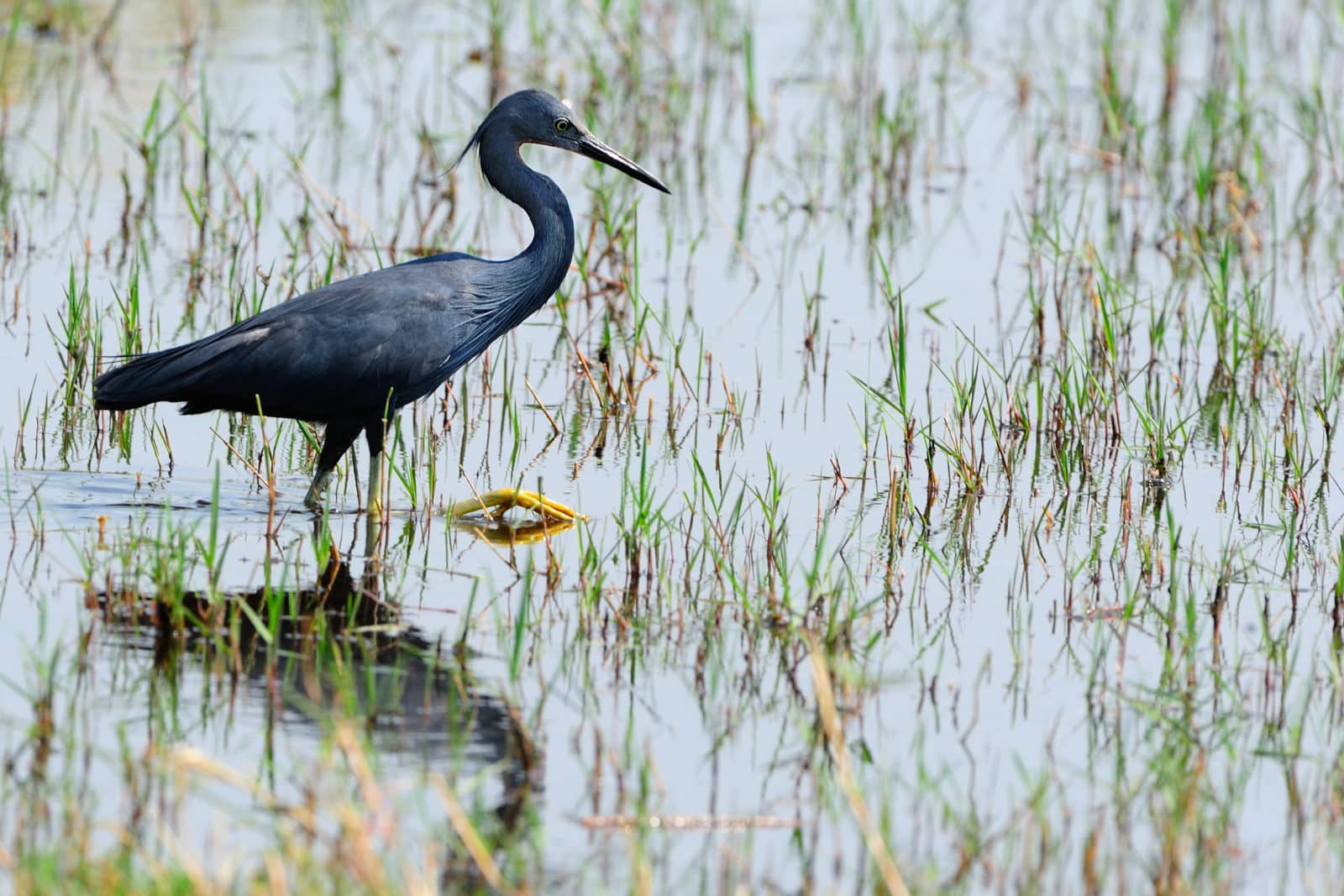
Almost totally confined to the Okavango Delta, the Slaty Egret is closely monitored by conservation groups such as Birdlife Botswana. Its ideal hunting ground being that of shallow floodplains in the delta, competition for food resources such as frogs, small fish (mostly bream) and other small water animals is high between the Slaty Egret and other aquatic birds such as Spoonbills, Kingfishers and Herons. Interestingly, the characteristic action of egrets to place their wings over their heads forming an umbrella over the water to assist in fishing is not displayed by this particular egret.
WHITE -BACKED NIGHT HERON (GORSACHIUS LEUCONOTUS)
Considered to be quite a ‘skulking’’ bird, the white-backed night heron is most likely to be seen on a mokoro excursion within the iconic Okavango Delta – the inland river Delta system being a stronghold for this species. During the day, they are almost invisible, hugging tightly to the shaded riverbank vegetation and becoming more active as the evening approaches. Having large red eyes and a prominent display of feathers on top of its head, this piscivore (fish-eating) bird is a scarce species with incredible hunting skills. Possessing specialised neck vertebrae to support its sharp strong bill, this bird coils its neck into an S-shape position before striking out at immense speeds at unsuspecting fish under the surface of the water.
MALACHITE KINGFISHER (ALCEDO CRISTATA)
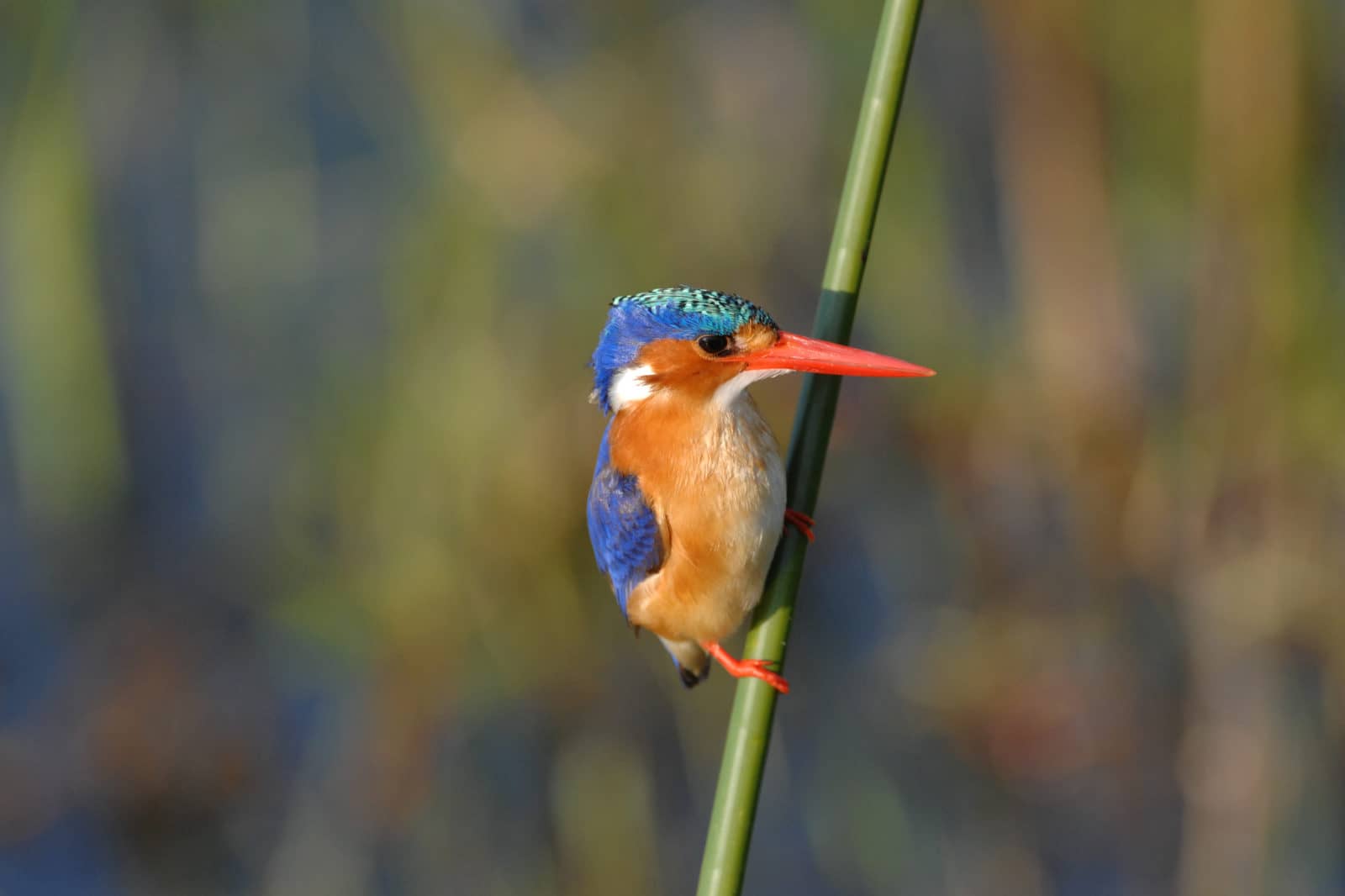
Dragonflies with their outstretched wings and damsels with theirs folded are one of the best understood small groups in the Okavango Delta which is home to over 99 dragonfly species. These vibrant species are drawn to the waters of the Okavango Delta by their need to breed in water, in fact much of their life is spent there as fierce larvae that eat other animals.
Which species are found in a particular area is related to patterns of water availability and flooding. For example, dragonflies around temporary pools are typical of the species found at short lived rainwater pools in the dry Kalahari. These species have very short life cycles emerging only 30 days after the eggs have been laid. Those species living on the permanent waters, by contrast, require water throughout. The greatest variety of species are found where both permanent and temporary waters are close together.
WATTLED CRANE (BUGERANUS CARUNCULATUS)

One of 7 most threatened birds in Botswana, the Wattled Crane has its highest concentration of population individuals specifically in the Okavango Delta of Botswana. Aptly named after the ‘wattles of skin that hang from their chin, these birds can visibly indicate their mood – the wattles shrink if the crane is nervous or agitated and extend in length if they are excited.
Weighing in at approximately 8kg, the Wattled Crane is severely threatened with only 7000 birds remaining globally. Major conservation efforts and projects are underway to further protect these birds who at an average height of more than 5 feet can stand taller than an adult human being. With an irregular breeding cycle, it is estimated that approximately only 13% of all fledglings survive, many of them falling prey to the numerous raptors and predators that frequent the Okavango wetlands.
PYGMY GOOSE (NETTAPUS AURITUS)
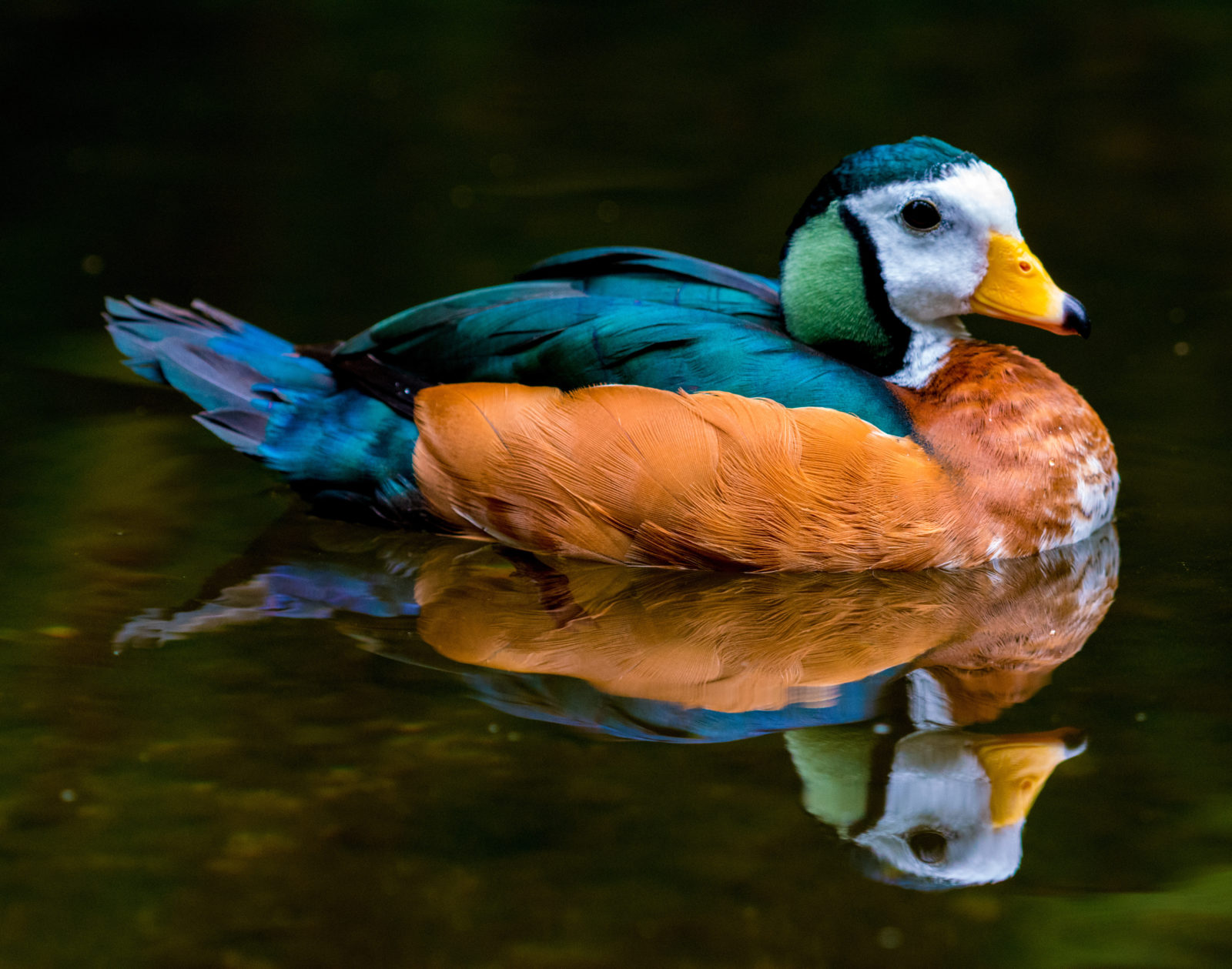
Holding the record as Africa’s smallest waterfowl, the African Pygmy goose is a shy elusive species that tends to avoid large open areas of water. With its striking rufous underparts, black, white and green facial colouring, this small duck-like creature prefers still standing water environments often covered in lily pads. Its diet consists mostly of small fish (fry), grass seeds and a selection of aquatic plant materials. Well-renowned for being a nomadic waterfowl, it is a favourite food source for the African Hawk Eagle.
With over 600 recorded species and counting, Botswana is a sought after destination on for keen birders. With habitats ranging from wet Okavango delta to semi-desert bush covered largely by dry tree, shrub and grass savanna, both water loving birds and drier country bird species occur here. Thirteen Important Birding Areas have been recognised in Botswana including Chobe National Park, Linyanti Swamps, the Okavango Delta, Makgadikgadi Pans, Central Kalahari and Khutse Game Reserves, Mannyelanong Game Reserve and the Kgalagadi Trans-Frontier Park.
Treats for avid birdwatchers include populations of globally threatened Wattled Crane and Slaty Egret in the north which are of international importance. When flooded, Sowa Pan, to the east of the Makgadikgadi Pans, attracts globally significant numbers of Lesser and Greater Flamingos.
Within the Kalahari sandveld ecosystem where vegetation consists mainly of low shrubs and bushes interspersed with patches of woodland, expect to see Plum-coloured and Cape Glossy Starlings, Arrow-marked Babbler, Bradfield’s Hornbill, Barred Owl, Bateleur Eagle, Ant-eating Chat, Three-streaked and Black-crowned Tchagras. Arid Central and south-west areas (including the Kgalagadi Transfrontier Park) support Ostrich and birds of prey such as Gabar and Pale Chanting Goshawks, Black-breasted Snake Eagle, Greater Kestrel and the Kori Bustard as well as a notable number of smaller species.
GREATER AND LESSER FLAMINGOS (PHOENICOPTERUS ROSEUS /PHOENICONAIAS MINOR)
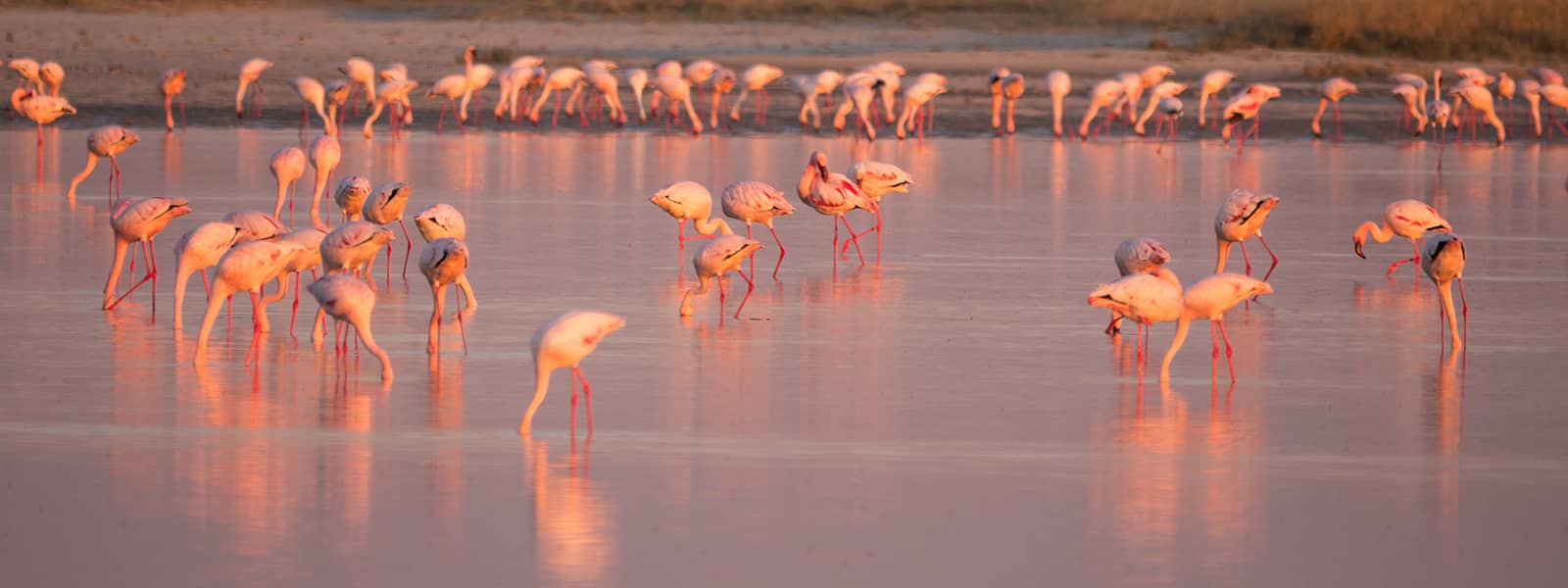

Nata Bird Sanctuary is renowned for its incredible flamingo viewing opportunities. Located just North East of Sua Pan, this protected area forms part of the Makgadigadi Salt Pans. The sanctuary is internationally recognised as the largest breeding area worldwide of the Lesser and Greater Flamingo. Attracted by the rich food sources of small shrimp living in salt and alkaline waters, worms and small crustaceans (preferred by Greater Flamingo) and algae, usually found in hot and brackish water-loving algae (Lesser flamingos), this site becomes a feast for the birding eye .
Every year, during the rainy season, tens of thousands of flamingos’ flock to the pan to breed. The timing of egg laying is of utmost importance with the focus being on hatching the eggs and the young birds learning to fly before the salt pans dry up again once more.
LILAC-BREASTED ROLLER (CORACIAS CAUDATUS)
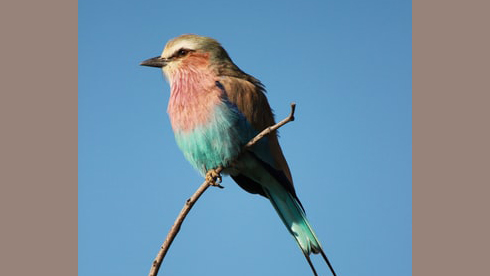

With its array of spectacular colours of creamy white, bright blue, tan, purple, lilac and turquoise, the Lilac-breasted Roller is one of Botswana’s (and Africa’s) most beautiful birds. Tricky to capture on camera, this bird gains its name from the rolling, tumbling flying action that expertly displays its intense colouring. A skilled insect hunter, the roller uses its own shadow to pinpoint visible prey by constantly keeping the sun at its back. Frogs, lizards, insects, scorpions and occasionally tiny birds make up the roller’s diet. Mating for life, both males and females vigorously protect the nesting site and in doing so are known to fight off much larger raptors. It is interesting to note that during bushveld fires, Rollers typically hang about the edges of the fire, ready to seize any unsuspecting insect or small creature desperate to escape the heat of the flames.
KORI BUSTARD (ARDEOTIS KORI)
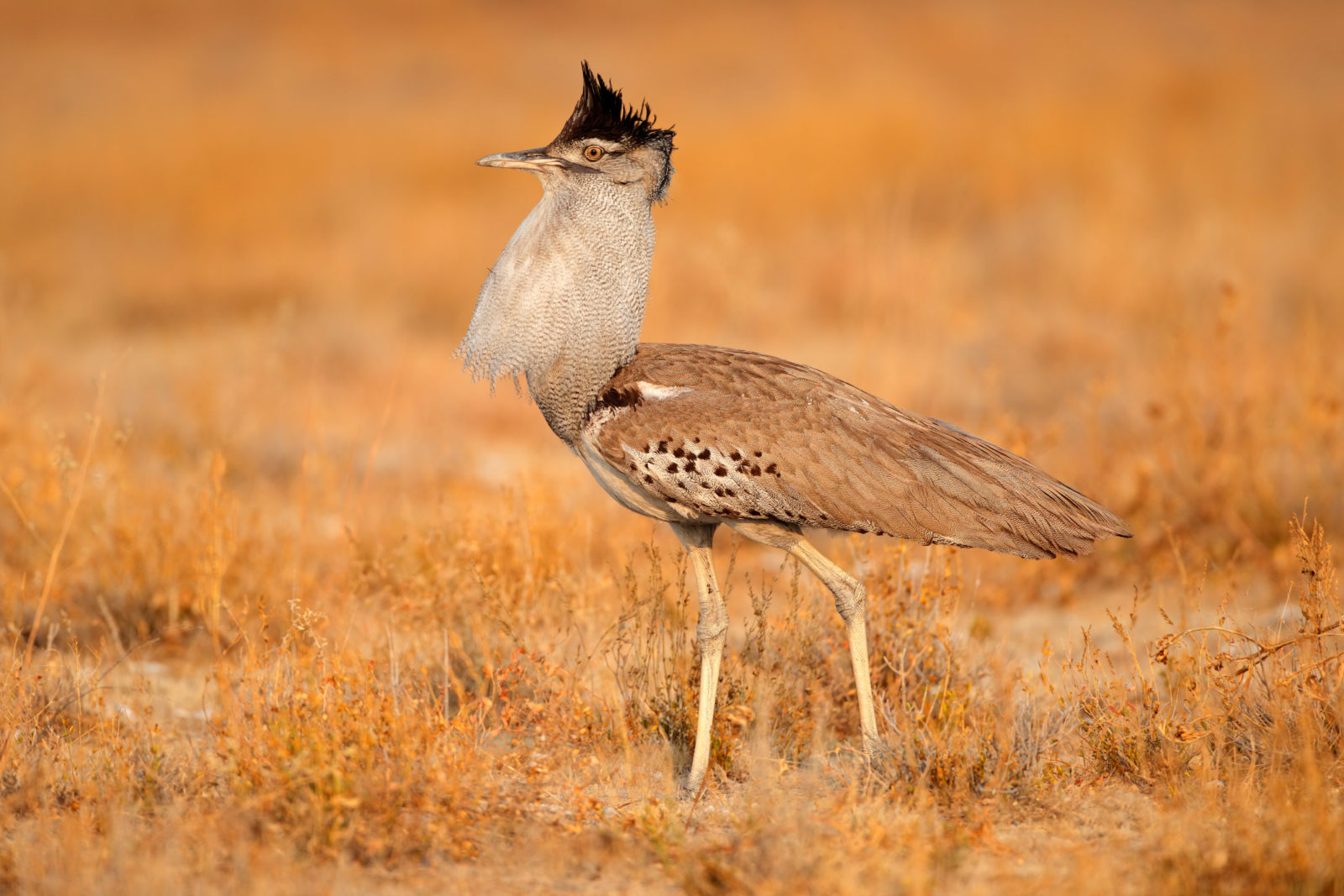

Botswana’s national bird. The threatened Kori Bustard is the largest flying African bird, weighing up to 20kgs. Found mostly on the Central Kalahari game reserve, Chobe, Tuli Block region and Kgalagadi Transfrontier Park. These birds can survive to an of approximately 20 years in the wild. Earning the nickname of “gum peacock “in South Africa, omnivorous bustards (birds that eat both plant and animal matter) are known to like eating the gum of Acacia trees. Several historical sites of San Rock Art depict the Kori Bustard as a revered bird. Numbers have dwindled due to them being hunted as a food source, lack of habitat from increase in domestic farming and insect poisons used by farmers. As with many other birds, power lines are also a point of concern.
PYGMY GOOSE (NETTAPUS AURITUS)



Holding the record as Africa’s smallest waterfowl, the African Pygmy goose is a shy elusive species that tends to avoid large open areas of water. With its striking rufous underparts, black, white and green facial colouring, this small duck-like creature prefers still standing water environments often covered in lily pads. Its diet consists mostly of small fish (fry), grass seeds and a selection of aquatic plant materials. Well-renowned for being a nomadic waterfowl, it is a favourite food source for the African Hawk Eagle.
BATELEUR EAGLE (TERATHOPIUS ECAUDATUS)


Along the dry Savute Channel, in the open grasslands, the Bateleur Eagle dominates the skies. A medium sized snake, the Bateleur is both a hunter and scavenger and will easily attack other predators for food .It is often the first scavenger on the scene of smaller carcasses .This can present a problem if farmers are poising carcasses to detract predators from livestock. Deriving its name from the French word for ‘tumbler’’ or acrobat, the Bateleur eagle has a distinctive flying motion, tilting from side to side as if balancing in the air. Hunting in wide sweeping circles, this bird is fiercely territorial and won’t hesitate to attack mid-air. The short tail allows the Bateleur to walk backwards in the grass – an efficient method of capturing evasive snakes in the long grass.
When it comes to breeding patterns, only one egg is laid at a time and the juvenile survival rate sits at approximately 75%. These majestic birds can often be seen sunning themselves as they spread out their wings and soak up the warmth of the sun’s rays.
SOUTHERN GROUND HORBILL (Bucorvus leadbeateri)


With adapted feathers for eyelashes it’s hard to beat those of the southern ground hornbill (bucorvus leadbeateri). These striking are about the size of a turkey, usually seen strutting through the bush snapping their dexterous beaks at anything in their path – from insects to small birds, rodents and snakes. By inflating the red, balloon-like wattle below their bill they are able to amplify their call – there are 5 different calls but the low booming call usually made in the morning is the most remarkable, resembling that of a lion! Ground hornbills are social birds, usually seen in families as they walk through the savanna. They are slow breeders, a pair raising on average just one chick every 9 years. They are co-operative breeders, with one dominate breeding pair in a social group, and the rest of the birds helping to raise the chicks as helpers. Ground hornbills are one of the world’s longest lived birds, living up to 50-60 years in the wild and 70 years in captivity. They are found across Botswana, mainly in the north.
ROCK PRATINCOLE (GLAREOLA NUCHALIS)
Breeding near Kasane at the Chobe rapids, the Rock Pratincole is classified as a native African wading bird. This small, short-legged species is mostly discovered perched on rocks alongside fast flowing rivers. Although the current population trend is not entirely known, it is suspected that numbers of Rock Pratincoles are decreasing due to the loss of preferred habitat. This bird has distinctive dull grey or brown plumage with a white ‘’collar’’. Occurring in flocks of approximately 26 pairs in and on the rocks, Rock Pratincoles’ preferred diet is insects which they catch in flight during the early hours of the morning and early evening. They are to be found wading in shallow water during the heat of the day and very often can be seen scavenging for insects while perched on the backs of hippopotamus.
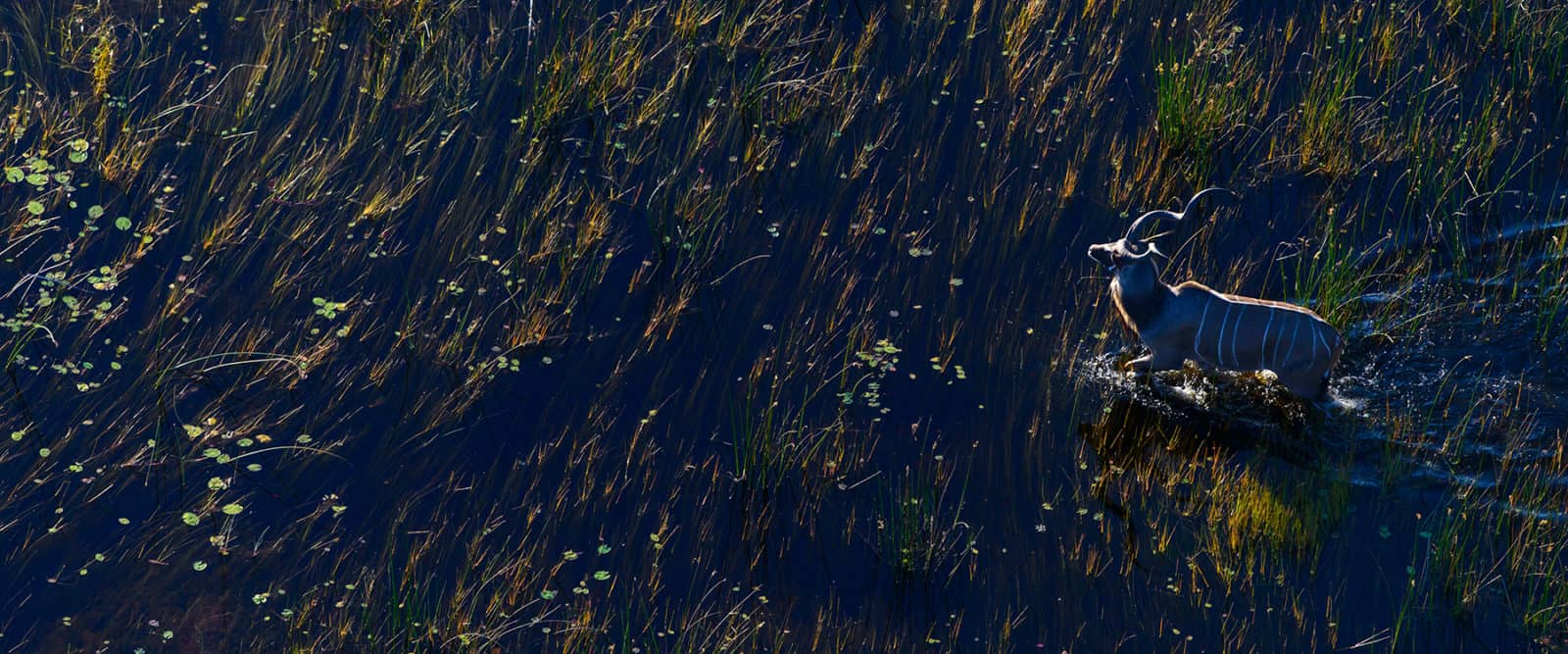

Contact us for more information and to start planning your Okavango safari
Contact